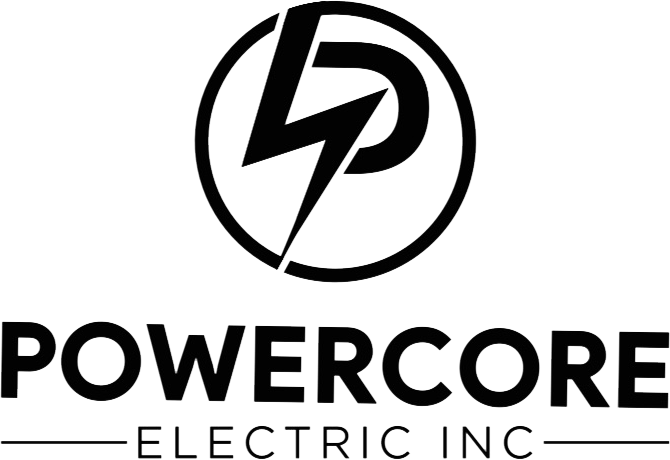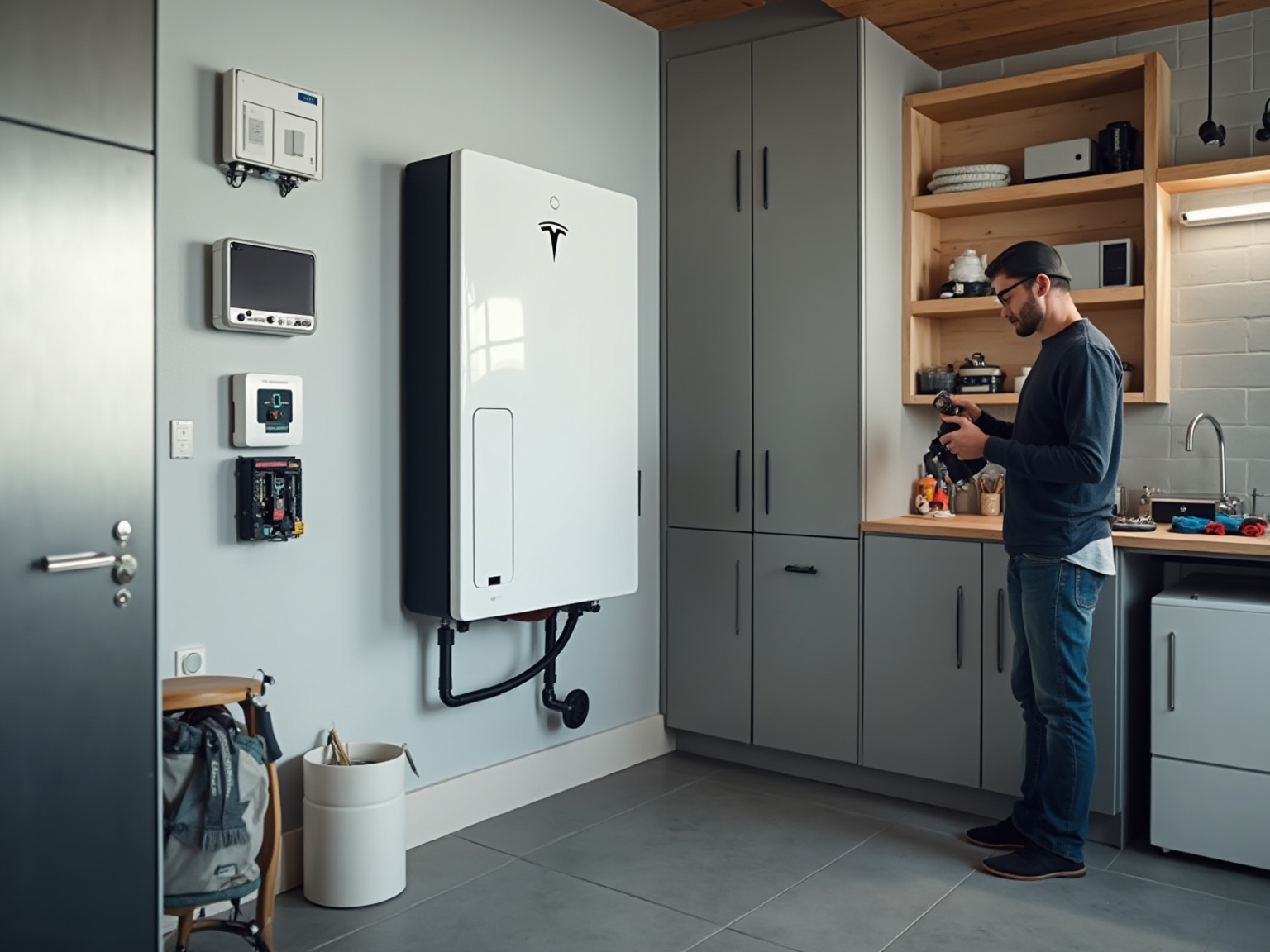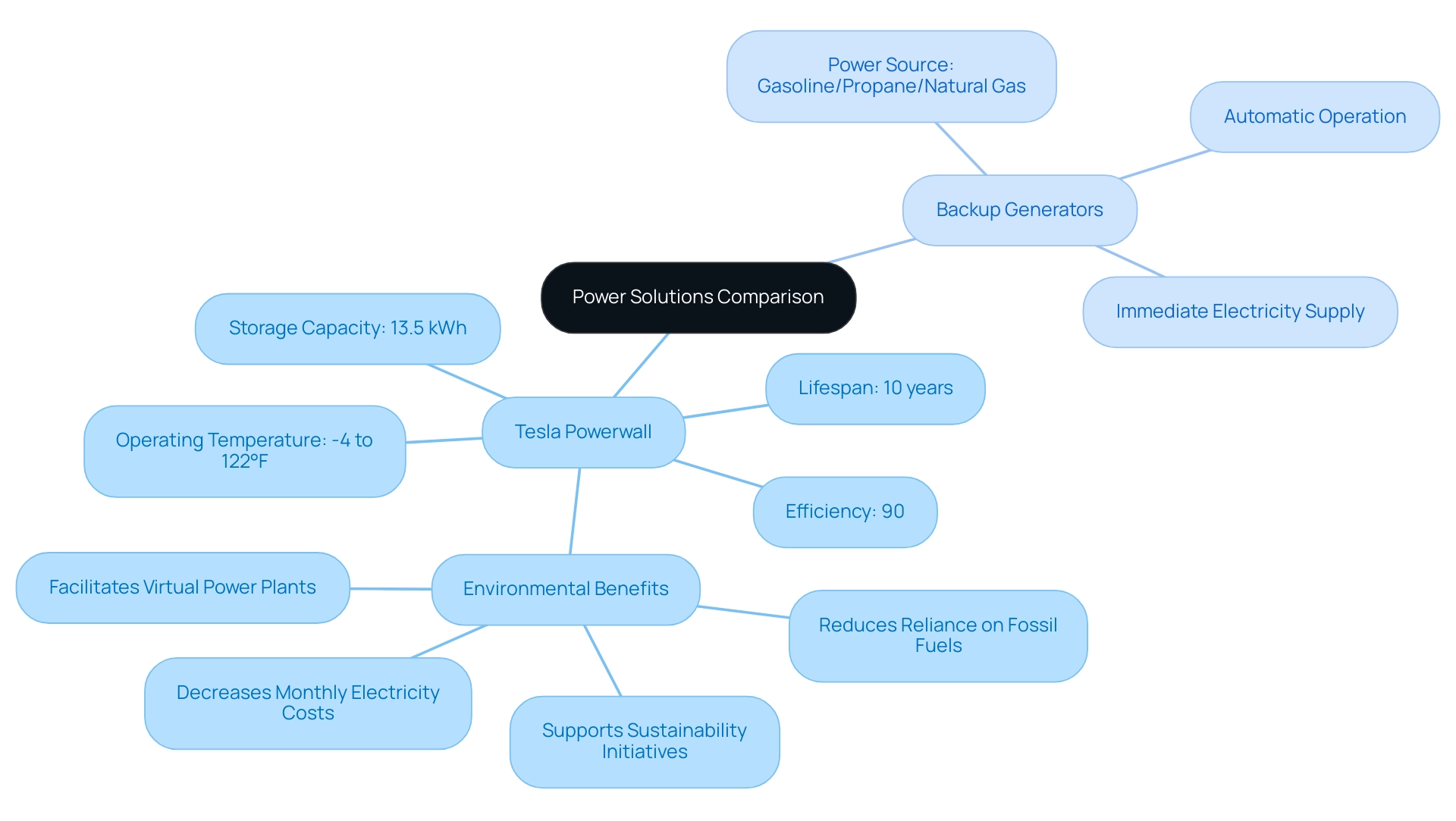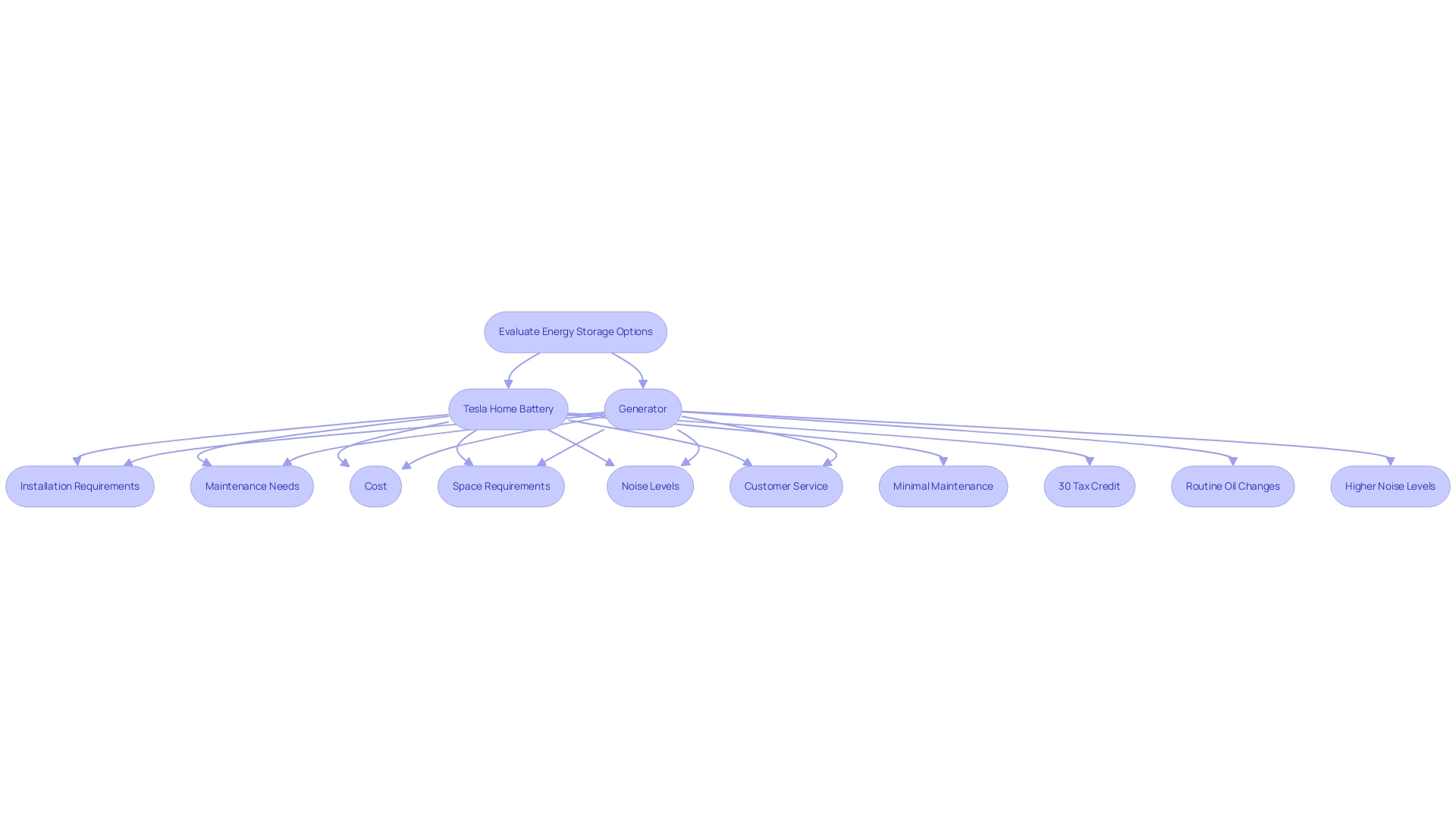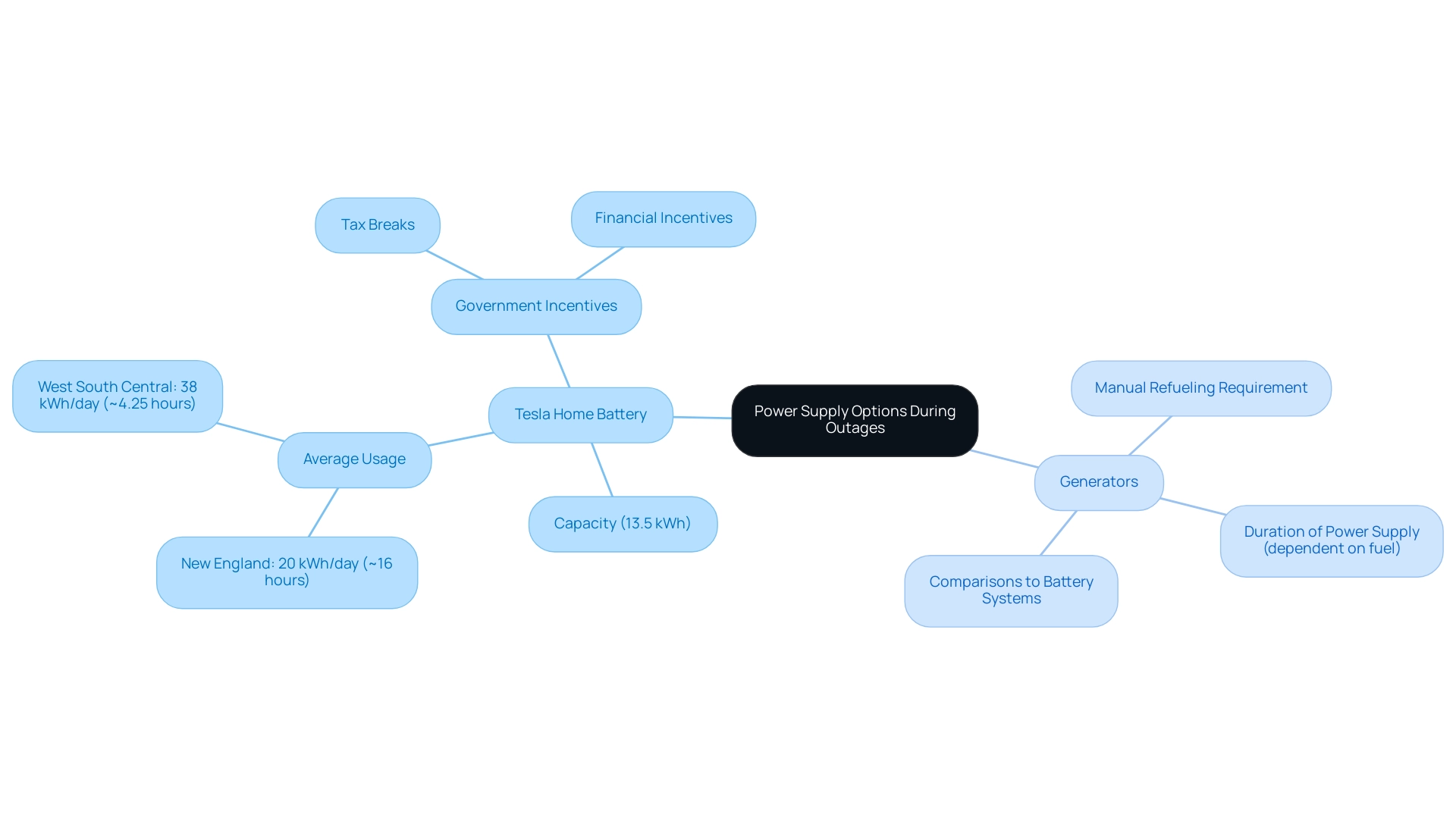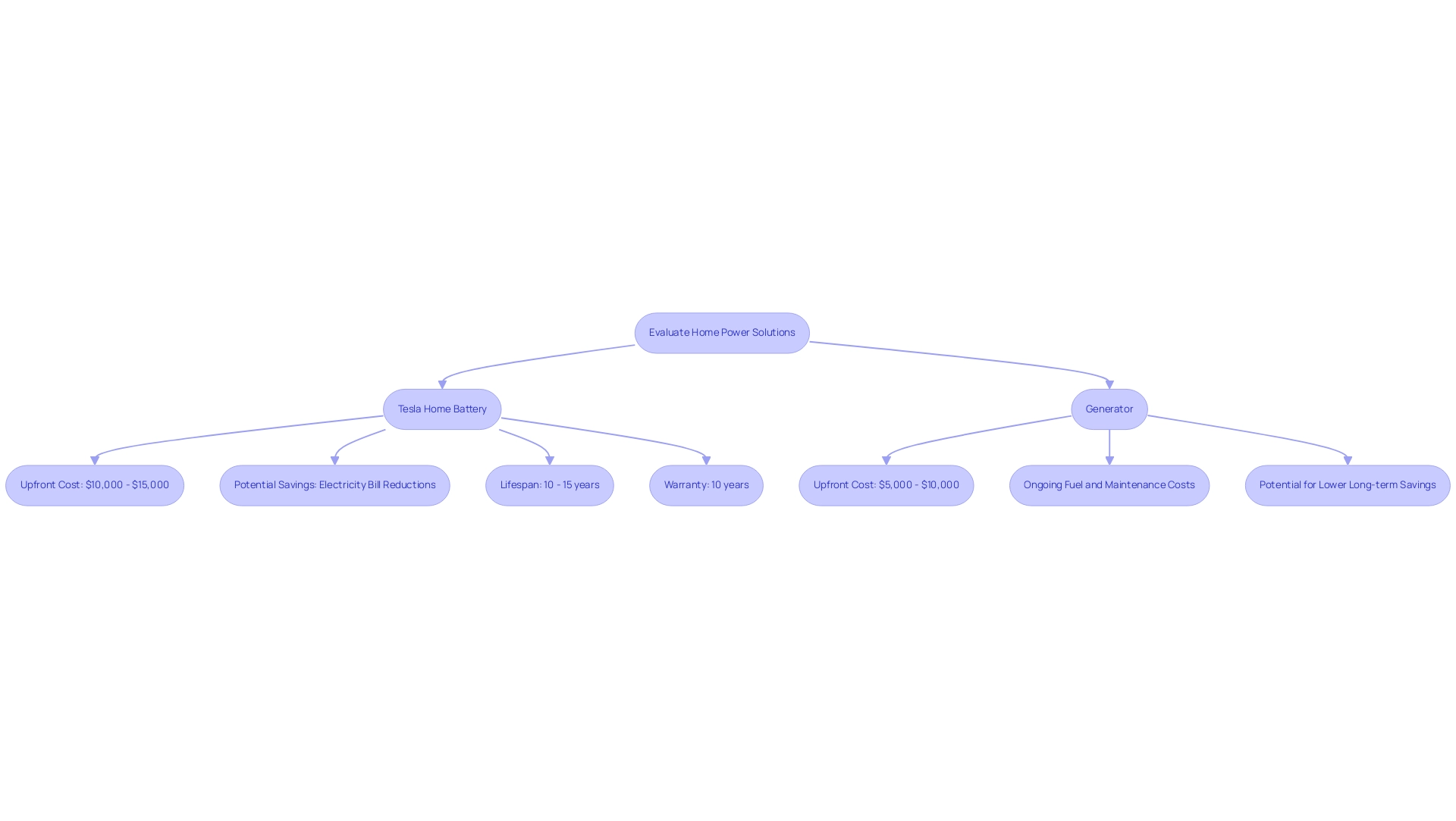Overview
The article compares Tesla home batteries and traditional generators as power solutions, highlighting the Tesla Powerwall’s advantages in efficiency, environmental impact, and long-term cost savings. It supports this by detailing the Powerwall’s ability to store renewable energy, its minimal maintenance needs, and the financial incentives available, contrasting these with the higher ongoing costs and environmental drawbacks associated with gasoline-powered generators.
Introduction
Choosing the right energy solution for a home can feel like navigating a maze, especially with the growing popularity of innovative technologies like the Tesla Powerwall and traditional backup generators. Homeowners today are faced with a key decision: should they embrace the eco-friendly, energy-efficient capabilities of a battery system that harnesses solar power, or rely on the tried-and-true reliability of a generator fueled by fossil fuels?
This article delves into the essential differences between these two options, exploring:
- Performance during outages
- Environmental impact
- Installation requirements
- Financial considerations
By understanding the unique advantages and challenges each system presents, homeowners can make a well-informed choice that aligns with their energy needs and sustainability goals.
Comparing Tesla Powerwall and Backup Generators: An Overview
The Tesla home battery system distinguishes itself as an advanced device that stores power from both photovoltaic panels and the grid, providing dependable backup during outages. This innovative solution not only helps reduce reliance on fossil fuels but also enhances efficiency by storing excess solar power for use during peak hours or outages. The battery system has a storage capacity of 13.5 kWh, an efficiency rating of 90% round-trip, and a lifespan of about 10 years, making it a strong option for power storage.
Operating effectively in temperatures ranging from -4 to 122 degrees Fahrenheit, this energy storage system is designed to perform under various environmental conditions. In contrast, traditional backup generators, powered by gasoline, propane, or natural gas, spring into action automatically during power outages, ensuring immediate electricity supply. While both systems aim to provide uninterrupted power, they cater to different power requirements and philosophies.
The storage system is especially ideal for environmentally aware homeowners keen to enhance their renewable resource use and aid in sustainability initiatives. With its capacity to facilitate the establishment of virtual power plants, the battery encourages autonomy while possibly decreasing monthly electricity costs by storing surplus solar power for future use. For instance, one Tesla energy storage unit can supply essential appliances for 24 to 36 hours, depending on conditions, although most residences may gain from having three or more for complete whole-house backup.
When comparing models, the second version offers similar features but has a lower efficiency rating of 89% and a shorter lifespan of 8 years compared to the third version, which boasts enhanced software capabilities and better energy management. As you evaluate your choices, keep in mind that federal and local incentives might be accessible for acquiring batteries for residential use. Additionally, if you’re weighing different models, a comparative analysis of the Powerwall 2 vs. Powerwall 3 can help clarify which option best meets your needs.
Don’t forget to check installation guides for residential EV charging points to optimize your power solutions. Ultimately, the choice between Tesla home battery vs generator is not just about power; it’s about making a conscious decision for the environment.
Installation and Maintenance: Key Considerations for Power Solutions
When evaluating energy options for your residence, comprehending the operation of photovoltaic panels and the differences between the Tesla home battery vs generator for energy storage is crucial. Solar panels work by converting sunlight into electricity through photovoltaic cells, which generate direct current (DC) that is then converted to alternating current (AC) for use in your home. For instance, installing a Tesla energy storage system typically requires professional installation, especially if you’re integrating it into your existing solar system or connecting it to the electrical grid.
According to Catherine Lane, Written Content Manager at Reviews, the installation of a Tesla battery system can cost around $16,800 before any incentives, varying by location. A significant advantage of the device is its minimal maintenance, which mainly involves monitoring software updates and performing occasional battery checks to ensure everything operates smoothly. Additionally, it qualifies for a 30% federal renewable energy tax credit, potentially lowering your overall investment.
In contrast, when considering the Tesla home battery vs generator, the latter can demand more attention. They require proper installation and regular maintenance checks, including routine oil changes and careful fuel management—imperative for reliability when the power goes out, which is an important factor to consider in the Tesla home battery vs generator comparison. Moreover, consider the space each system requires. The Powerwall’s sleek design allows it to fit neatly into your residence, while backup generators usually need more outdoor space and proper ventilation for safe operation.
Keep in mind that a typical backup generator operates at 77 dBA at 1 meter, which might be a concern if noise levels are important to you. Additionally, while Tesla’s battery storage solutions offer numerous benefits, some customers have raised concerns about the company’s customer service reputation, which is an important factor to consider for long-term investments. Furthermore, homeowners may benefit from government programs that provide incentives for solar power adoption, making it more affordable.
By assessing these differences between the Tesla home battery vs generator, you can make a well-informed decision that aligns with your residence, lifestyle, and aspirations for autonomy.
Performance During Outages: Reliability and Duration of Power Supply
When the lights go out, homeowners often consider the Tesla home battery vs generator for support. The Powerwall, with its 13.5 kWh capacity, can provide electricity for several hours, depending on the household’s power usage. For example:
- New England residences may consume around 20 kWh each day, offering roughly 16 hours of power.
- Homes in the West South Central area average 38 kWh, equating to about 4.25 hours of electricity.
This intelligent power management system ensures that essential appliances receive priority, effectively maximizing the available power during outages. On the other hand, traditional backup generators can provide power for as long as they have fuel, making them a go-to solution for extended outages, though they do require manual refueling. Homeowners should assess their typical power requirements during outages and consider the efficiency of resource management to determine which option, a Tesla home battery vs generator, offers the most reliability for their unique circumstances.
Furthermore, government initiatives promoting solar technology adoption can offer financial incentives and tax reductions for the Tesla battery storage system, increasing its attractiveness for environmentally aware homeowners. Many users have found the battery storage system’s reliability during power outages to be advantageous, and as one well-known member pointed out, ‘UL1741 inverters have only been required in California since September 2017.’ This highlights the evolving landscape of home power solutions, as the reliability of systems like the Powerwall continues to improve.
Moreover, examining leading batteries for power storage, such as the LG Chem RESU and Sonnen Eco, can provide homeowners extra choices customized to their power requirements. With various cleaning services available to maintain solar panel efficiency, homeowners are better equipped than ever to make informed choices about their power solutions. In general, battery systems are gaining popularity as reliable choices for contemporary resource management.
Environmental Impact: Assessing Carbon Footprint and Noise Pollution
The Tesla energy storage system truly shines as an eco-friendly energy solution, dedicated to sustainability by harnessing renewable energy sources and operating with zero emissions. This innovative battery system is designed for flexibility, allowing for both indoor and outdoor installations with versatile mounting options—whether wall-mounted or floor-mounted—making it a perfect fit for various residential setups. When combined with solar panels, the battery storage system not only significantly reduces your home’s carbon footprint but also helps you save on electricity bills each month.
A compelling case study highlights that over a ten-year span, this energy storage system presents a favorable comparison in the Tesla home battery vs generator debate, boasting a lower cost of ownership compared to traditional backup generators, which, while providing power, typically rely on fossil fuels, leading to higher emissions and noticeable noise pollution. Though advancements have made modern generators quieter, they still can’t match the silent operation of a Tesla home battery vs generator system. It’s worth noting that while photovoltaic panels do have a carbon footprint, the life-cycle emissions associated with this electricity are about 12 times lower than those from natural gas and 20 times lower than coal.
For homeowners concerned about their environmental impact, the energy storage system seamlessly integrates into an eco-friendly lifestyle and even allows participation in Virtual Power Plants in select regions, potentially offering financial incentives. In considering a solar battery, key factors such as capacity, efficiency, lifespan, and price are crucial; this product provides a capacity of 13.5 kWh and an efficiency rating of 90%, making it a strong contender in the market. When comparing the 2 and 3 models, the latter boasts improved efficiency and a higher capacity, making it an even more appealing choice for eco-conscious homeowners.
Ultimately, if you’re prioritizing sustainability, this energy storage solution stands out as a smart and responsible choice, reinforcing your commitment to a greener future.
Financial Considerations: Costs, Savings, and Incentives for Home Power Solutions
When evaluating power solutions for your residence, comparing the Tesla home battery vs generator, the upfront expense of a Tesla battery system can appear somewhat intimidating, usually falling between $10,000 and $15,000 when you include installation. However, this investment in a Tesla home battery vs generator can lead to significant savings on your electricity bills by harnessing stored energy from the sun, especially with the current financial incentives available for installation, such as the federal tax credit for energy systems. Significantly, the average solar panel system combined with one Tesla battery can recoup its cost in approximately 14 years, rendering it an attractive long-term investment for environmentally aware homeowners.
On the other hand, in the discussion of Tesla home battery vs generator, backup generators generally present a more budget-friendly upfront cost, often between $5,000 and $10,000. But don’t overlook the ongoing fuel and maintenance expenses that can accumulate over time. For instance, while a generator might seem cheaper initially, when evaluating the Tesla home battery vs generator, those recurring costs can overshadow the initial savings.
Additionally, in the discussion of Tesla home battery vs generator, the Tesla battery storage system 3 boasts a lifespan of 10 to 15 years and comes with a 10-year warranty, underscoring its reliability and value. Furthermore, the Tesla battery storage models, including the 2, Plus, and 3 versions, all have a usable capacity of 13.5 kWh but differ in power output and integration capabilities. The Powerwall 3 provides the highest continuous output at 11.5 kW, which could significantly influence your power requirements and decision-making process.
Moreover, Tesla home chargers typically range from $400 to $700, depending on the model and installation requirements, adding another layer to your energy solution considerations. As you weigh your options, think about not just the upfront investment, but also how each solution, including the Tesla home battery vs generator, integrates into your long-term financial picture. With these insights, including the benefits of solar-powered heating solutions available in California, you can better determine which option truly offers the best financial benefits tailored to your unique needs.
Conclusion
Choosing between a Tesla Powerwall and a traditional backup generator ultimately comes down to individual needs and values. The Powerwall presents an innovative, eco-friendly solution that integrates seamlessly with solar energy systems, providing reliable power during outages while significantly reducing carbon footprints. Its minimal maintenance requirements and potential financial incentives make it an appealing choice for those looking to embrace sustainability without sacrificing efficiency.
On the other hand, traditional backup generators offer immediate power during outages, making them a practical option for homeowners who prioritize reliability and extended energy supply. However, the ongoing fuel and maintenance costs can accumulate, potentially offsetting the initial savings.
As homeowners weigh these options, it’s essential to consider not just the upfront costs but also the long-term financial implications and environmental impacts. By understanding the unique advantages and challenges of each solution, homeowners can make informed decisions that align with their energy needs and sustainability goals. Ultimately, whether opting for the advanced capabilities of the Powerwall or the tried-and-true reliability of a generator, the choice made today can pave the way for a more resilient and eco-conscious future.
